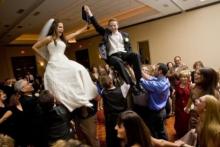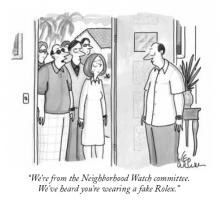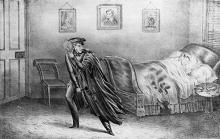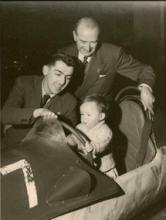Americans love labels. You put a label on it and you give it an identity, you humanize it. One of the most elusive things we've attempted to label is generations; those loosely related groups of individuals born in the same relative time period and disposed to the same relative cultural experience (notice how it's all relative). Visit any number of publications and you'll get relatively (again) similar accounts of the generational periods, qualities, and ranges of dates in which its members were born.
- The Greatest Generation from 1901 - 1925, came of age during the Great Depression and was involved in one or both fo the World Wars. (Dubbed by Tom brokaw in his book of the same name.)
- The Silent Generation from 1925-1945, comprised those individuals that came into the world during the Great Depression and sandwiched between two world wars.
- The Baby Boomers, 1945-1960’s were products of a suddenly prosperous country on the heels of a World War that catapulted the U.S. to the top of the global charts.
- Generation X, 1960’s to 1980, were children of the Baby Boomers that are known for their need of individual uniqueness and resulting counter-culture movements. X'ers are generally thought to have ended right around 1980.
After that it gets a little hard to discern where the generalities fall because people born after 1980 really have yet to make a mark upon the world and we have yet to determine what exactly their "cultural experience" would be in the context of our national narrative. People born between the early 1980’s and the early 2000’s are more characterized by their adolescence in a world of fast-paced change than any cultural imprint made by their age demographic. There have been attempts to label by people trying to get a jump on the nomenclature: Generation Y, or Z, the I Generation, the Nintendo Generation Y, the Internet Generation, Millenials, Generation @...the list goes on.
I was born in 1980, came of age during the advent of the internet, and now arrive in the second decade of the 21st century at the age of 30. I latched on to the grunge movement of the early to mid nineties, a cultural hiccup it seems, and cemented my identity around the turn of the latest century which will forever be characterized more by the cultural fallout of 9/11 than by anything else. I feel like an outlier, caught between the cynicism and independent self-reliance of the X Generation, and the confident optimism and comfort with ambiguity of the next generation (often referred to, appropriately, as Millenials).
Giving credence to this type of generalized characterization, businesses and organizational theory has been attempting to integrate generational identity into their workplaces and human resources considerations. In a post published on Forbes.com, Rawn Shah examines the implications of five different generations together in the workforce (older generations working longer and the upcoming “Millenials” entering now). According to one source, half the global workforce will be so-called Millenials by 2015. For organizational and business leaders, as well the diverse workforce, it becomes increasingly important for people to work in an inter-generational environment. Some organizations even provide a questionnaire to determine with which generation you best fit. This kind of “social learning”, Shah says, is integral to keeping an agile, dynamic, and interconnected workforce.
Members of previous generations will be required to adapt more to meet the changing landscape of the 21st century business model. Baby Boomers and some Gen X’ers may need to learn to adapt as quickly as Millenials, that have come of age in a world that is constantly changing. Millenials feel a comfort with uncertainty, with the ambiguity of whether the “next big thing” is really a thing, or just a passing phenomenon. Millenials thrive in the gray. However, Millenials, by the same right, function poorly alone, having grown up in a very interconnected world. A bit like a rower without their crew, they flounder in the water on their own. (Perhaps a reason another label of the Millenials has been “Tweens”, twenty-something that, even out of college, end up living with their parents for lack of self-motivation.)
Gen X’ers need to unlearn some of their stoic independence to be productive in such an agile work environment, with constantly changing demands and constantly collaborating with other professionals. The interconnectedness works against many stolid Gen X’ers that grew up in an environment wanting to make their own mark, and distrustful of “the establishment.”. Baby Boomers, likewise, have much to learn in the realms of technology and the modern landscape of business, but make up for it in work ethic and quality production.
On a bit of a side note, I feel the cultural divide between generations is, in the U.S., often perpetuated by formal education. Every person in the nation, without exception, has some experience within the educational system. The way the system is set up, however, favors an industrial widget approach where children are grouped by age. Rather than putting children with like abilities and developmental levels together, children spend most of their formative years mostly interacting with people of their own age (not even generation, but specific year of birth!) Where else in our lives are we daily surrounded only by people of the same age cohort? Never! This may sound strange coming from a public school teacher, but if we really want to address issues of 21st century competencies and academic achievement, we need to look at the basic approach in how children progress through school.
Though I may feel like somewhat of an outlier in terms of my generational identity (The PRC questionnaire would disagree, I got a 96% like a Millenial rating…) I understand that those characterizations mean nothing on an individual basis. Individuals are dynamic, changing, thinking beings no matter the year they were born. A person may embody some characteristics of a generation or may abandon them entirely. At any moment those ahead of, or behind, “the times” are outliers in their own right. Attempting to measure one’s place in society is like shooting at a moving target. In a rapidly changing world, the only people left out are the ones standing still.
Photo from 500race.org








